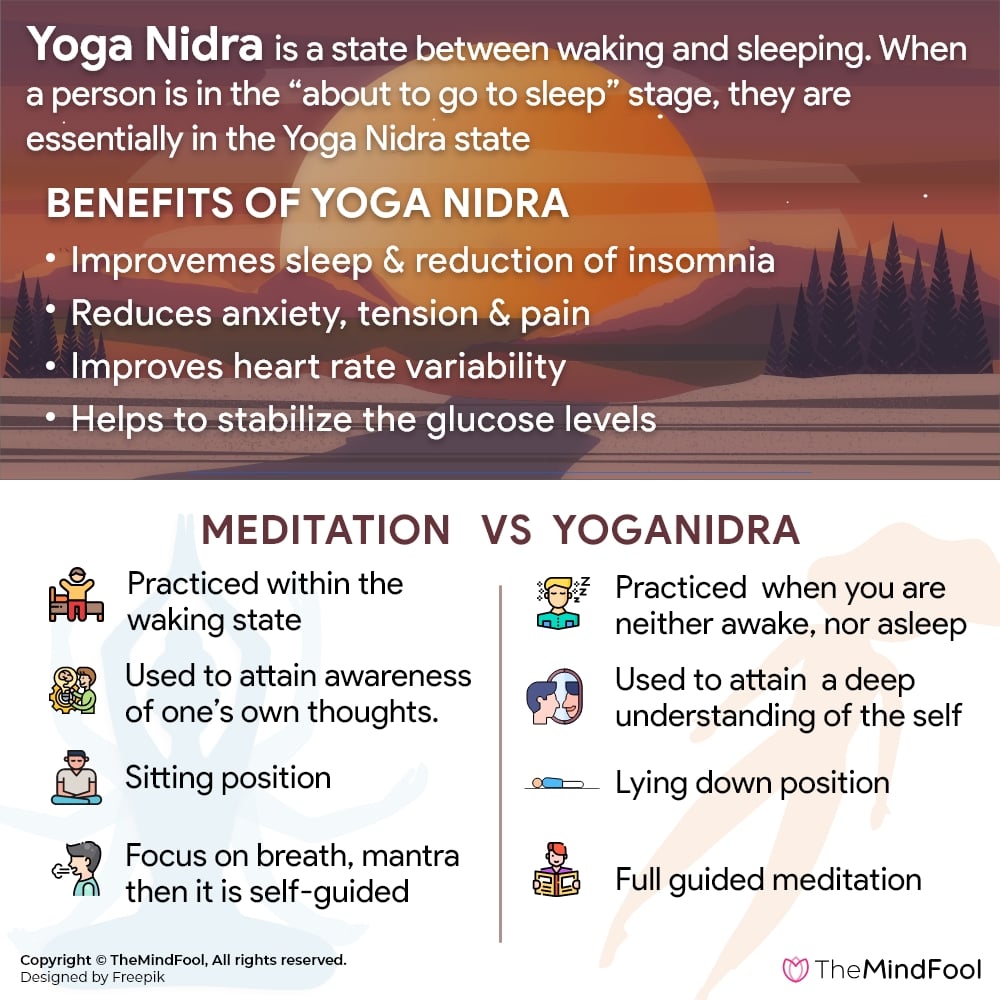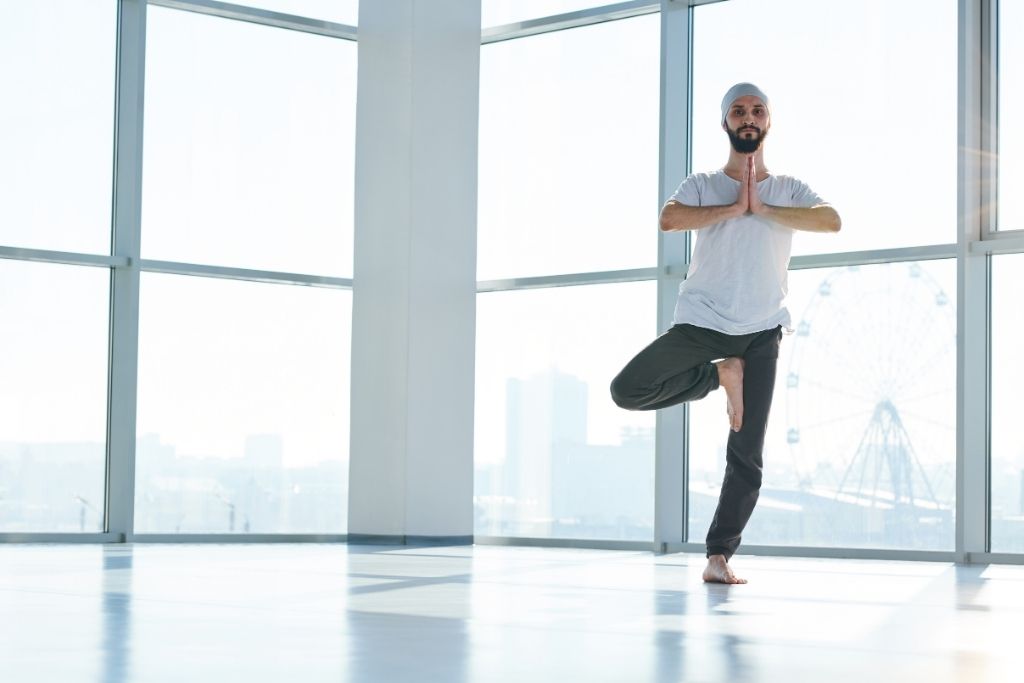
We get little commissions for purchases made through links in this post. Our editors carefully choose to promote only those products/services that resonate with our readers.
In today’s hectic lifestyle, almost everyone is suffering from some kind of mental issue. Whether it be clinically defined ones, like anxiety or Post Traumatic Stress Disorder (PTSD), so simple everyday problems that keep us up at night. Consequently, several types of alternative treatment methods have also cropped up. Yoga Nidra is one of them.
Yoga Nidra, also known as Yogic Sleep is a ground-breaking process that is slowly gaining popularity. It helps in reducing stress and anxiety and depression, and in some cases, PTSD as well. The practice was first seen in India but is now followed all over the world for treating various types of mood disorders.
What is Yoga Nidra?
SUMMARY
Yoga Nidra is a state between waking and sleeping. It has immense health benefits, and can help in developing a state of higher consciousness.
Yoga Nidra, in its very essence, is a special state of consciousness. It lies between waking and sleeping. When a person is in the “about to go to sleep” stage, they are essentially in the Yoga Nidra state. It is usually done in sessions of 30 minutes to 45 minutes at a time.
Yoga Nidra can sometimes happen on its own, when we try to fall asleep. But it can also be induced by forms of guided meditation methods. It can help with relieving stress and anxiety. It is also used for dealing with post-traumatic stress disorder.
In this state, the yogi, or the practitioner has completely relaxed their body. The guru or the teacher offers them guided meditation and verbal instructions, although this isn’t necessary, since Yoga Nidra can be practiced by yourself too, using guided meditation audio clips. Through this verbal instruction, the practitioners become more and more aware of their inner world and subconscious mind in a systematic manner.
Yoga Nidra is a completely different state of consciousness from meditation. In the latter, one has to focus on a singular object. It means turning your eyes inwards and watching what you are thinking. Instead of thinking what you are going to make for dinner, you watch the thought form and end, without getting attached to it or being carried away by it. Whereas in Yoga Nidra, the yogi is disconnected from all 5 senses. Out of these, 4 are internalised and only hearing is used to follow the given instructions.
Although they are quite different in their approaches, both mediation and yoga have the same goal. Both the yogic paths aim to achieve a state of meditative consciousness, which is known as samadhi in yoga. This meditative state is one of the most relaxed states of our consciousness.
On the other hand, Yoga Nidra results in the yogi developing a conscious awareness of their surroundings even in the deep sleep state.
TheMindFool Recommends
Yoga International lets you practice at home with the world’s top Yoga Teachers. Check them out!
What is The Meaning of Yoga Nidra?
Whether you have previous experience with Yoga Nidra, or you are entirely new to the world of meditation and yoga, you have to understand that Yoga Nidra has two distinct meanings.
1. The philosophical meaning
In Indian philosophical and mythological texts, Yoga Nidra is known as a state in which the Indian God Vishnu sleeps when Paralaya happens. Pralaya refers to the apocalypse, or destruction of the world and all creation.
According to Hindu mythology, Vishnu acts as the cohesive force keeping the fabric of the universe together. When he sleeps, the universe gets dissolved. However, when Yogis refer to Yoga Nidra, this is not the meaning they are thinking of.
2. The Yoga tantra technique
This meaning of Yoga Nidra is the most popular one. According to this, it is a tool for meditation and relaxation. It is derived from ancient tantra and has been developed over a long time. It induces a state of deep body-mind relaxation. The ultimate goal of Yoga Nidra according to this meaning is to inculcate a sense of profound self-awareness.
The Yoga Tantra technique allows one to remain aware when they enter into the dream and sleep states of the consciousness. It is also known as prajna in Mandukya Upanishad, which is a Hindu scripture. It is specifically related to the deep sleep state of our consciousness.
Yoga Nidra is not focused on observing your thoughts, but entering the state of mind between consciousness and unconsciousness, where you can make your Sankalpa, or your heartfelt desire, manifest. In the half wakeful state of consciousness, you can explore the full length and breadth of your innermost self, whether it is physical, mental, or spiritual.
NOTE
A Yoga Nidra session is often confused with lucid dreaming, but there is a vital difference between the two. In lucid dreaming, the person is aware of their dream environment, but they do not have any awareness of their actual, physical surroundings.

History and Philosophy behind Yoga Nidra
Yoga Nidra sees its origins as an ancient practice in India. Some sources have claimed that the concept is as old as yoga itself, and its first mention is seen in the Hindu scriptures, Upanishads. In the epic Mahabharata, it was mentioned that Lord Vishnu goes to Yoga Nidra to sleep after the end of every Yuga, which is an epoch or era.
On the other hand, some other sources claim that Yoga Nidra was first witnessed in the Samkhya philosophy, which was written down in 700 BC. According to this philosophy, there is a dualism in the world. There is a separation between the witness (purusha), and what is being witnessed (prakriti), for example, our feelings and thoughts, objects, and other humans. According to Samkhya, our happiness lies in becoming aware of the dualism.
TheMindFool Recommends
Looking for Yoga lifestyle garments and gear? Check Yoga Democracy – we love their designs!
Advaita Vedanta and the teachings of Kashmiri Shaivism, on the other hand, state that the objects we experience are not separate from us. They are a projection of all that we are witnessing, and we are connected to them. Yoga Nidra aims to help with exploring this connectedness and explore these objects within our awareness. All these philosophies are commonly known as non-dualist philosophies, and Yoga Nidra is an essential part of them.
You can also find references to Yoga Nidra in other philosophies years after it was expanded upon in the Upanishads. There are traces of this practice in Advaita Vedanta, a non-dualist philosophy, as well as some Tantric teachings found in Kashmiri Shaivism.
However, the concept has continued to evolve over time. Modern-day Yoga Nidra practice is a culmination of redefining and refining overages. Swami Satyananda Saraswati of Rishikesh was the first one who claimed to have experienced this state of consciousness.
Yoga Nidra in the Modern World
Swami Satyananda said that once, he fell asleep near a group of people who were chanting mantras. He had not heard them before, but when he woke up, he seemed to recognize them. The Yogis told him that his subtle body or subconscious had heard the mantras.
Satyanada then started studying the Hindu tantric scriptures. After much practice, he developed a deep relaxation system, known today as Yoga Nidra. According to him, Yoga Nidra is a state of mind that can open the deepest phases of our consciousness. The modern usage of the term was more or less coined by Satyanada, and it means deep relaxation and meditation, instead of the traditional meaning which refers to merging of the self with the divine universe.
Since it is a state of consciousness between wakefulness and sleeping, he suggested that it has a strong connection to the tantric practice of Nyasa. In this practice, Sanskrit mantras are placed in each part of the body mentally, while meditating and focusing on that part.
Anne Cushman, a Mindful Yoga teacher has further corroborated this. According to her, the body-sensing practice used in Nyasa is another variation of Yoga Nidra. In the west, Yoga Nidra was pioneered by Richard Miller. Miller has developed a system to use it for pain rehabilitation in soldiers.
Due to the nature of his work at the Walter Reed Army Medical Center and the US Department of Defense, Miller was able to spread the influence and benefits of Yoga Nidra to a large number of non-traditional settings, including veterans’ clinics, military bases, homeless shelters, jails, hospices, chemical dependency centers, and more.
Here, you can find some Yoga Nidra Guided Meditation Audio CDs and books by one of the most popular Yoga teachers, Richard Miller.
Yoga Nidra Benefits
Yoga Nidra and meditation have a buffet of health benefits – from mental and physiological, to aiding healing from various clinical disorders. Here is a brief overview of the same:
The Mental and Emotional Benefits
Yoga Nidra has immense benefits. It can be practiced by anyone, you don’t need to have extensive meditation or yoga experience to practice it, although, the benefits are much more profound when it is done in greater frequency.
Here are some of the most significant mental and emotional benefits of the practice:
1. Improvement in sleep and reduction of insomnia

Lack of sleep contributes to a variety of issues – like insomnia, depression, weak immune system, and burnout. Yoga Nidra can help in falling asleep faster, as well as staying asleep for longer periods of time. It does so by slowing down the wavelength in the mind when you enter the sleeping stage.
Just like with driving or turning off a car, sleeping requires you to power down your brain and your body before you fall asleep. Yoga Nidra trains your body and mind to do this before you reach the deep sleep state. As you sense your body with Yoga Nidra techniques, start noticing your natural breath, and while breathing mindfully, your body starts deep relaxation processes.
As a result, both your left and right brain are balanced, including the sympathetic and parasympathetic systems. This helps you remain asleep for longer, and sustains deep sleep. By calming the nervous system, and inculcating a sense of deep mental peace, Yoga Nidra can help with insomnia and improves sleep. Another benefit of Yoga Nidra is that it can also help reduce stress and aid better sleeping patterns and habits.
2. Detachment from one’s thoughts

In a Yoga Nidra class, you learn to immerse yourself in your natural resting state and calm your mind. As you do so, you learn how to recognize your thoughts as they come and go. This encourages the mind to develop a sense of higher awareness of its thought patterns.
Once you learn how to do that, you will also start integrating this higher awareness in your everyday life. This helps with restoration of the mind and all its senses to their natural physiological state of functioning. You will also learn how to let go of any negative thoughts, or unpleasant past experiences
3. Releasing tension and pain

Becoming more aware of the sensation within your body helps you become more aware of your tensions and stresses. Whatever holds you back, will be identified and confronted. This further helps with the release of negative thought patterns and emotions.
As a result, you develop an improved sense of self-regulation, see reduced levels of anxiety and stress, and see an improvement in your mood, quality of life, and general well-being. Incidentally, Yoga Nidra also helps prepare your mind for a disciplined yogic practice.
4. Reconnecting with yourself

With Yoga Nidra, you can create a space into your mind for you to learn about yourself. It opens up a window into your soul, and allows you to explore yourself through its reflective and restful techniques. This is done by setting an intention at the beginning of the practice, that is, reconnecting with yourself.
You have to communicate your intention to your instructor at the beginning of the practice. As you go through the steps of Yoga Nidra, you should allow challenging emotions to pass through you. Release all the unwanted energy, reconnect with your consciousness, and free yourself from all that does not serve you. Reconnecting with yourself will also help improve your self-esteem and self-improvement, aiding in self-acceptance and personal growth.
5. Getting the most out of life

Practicing Yoga Nidra on a regular basis can change your life for the better. It allows you to later your lifestyle and routine to your liking, and also inculcates a sense of deep joy and psychological well-being. Over time, you will see the world in a different way.
You will start drawing strength you’re your environment and start living in the present moment. You will also develop enough will power and inner strength to meet any difficulties that you may encounter later in life. Even in the darkest of times and the most unpleasant mental states, you will find joy, happiness, and gratitude.
Physiological Benefits
Yoga Nidra has the following effects on our body:
1. It causes an increase in the release of endogenous dopamine from the brain. This chemical is responsible for feelings of happiness, joy, and well-being.
2. It also results in a reduced desire for action, because of the reduction in blood flow to certain parts of the brain that are associated with controlling actions, such as the prefrontal cortex, the subcortex, and cerebellum.
3. Yoga Nidra improves heart rate variability, which is the variation of time intervals between heartbeats. This helps maintain the balance within the autonomic nervous system, which is responsible for the normal functioning of the body both in normal circumstances, as well as in adverse circumstances.
4. Yoga Nidra reduces autonomic symptoms of anxiety and tension, such as chest pains, headaches, sweating, abdominal problems, giddiness, palpitations, etc.
5. Yoga Nidra helps in the regulation of certain hormones and can also help with the stabilization of glucose levels. Researchers from the Indian Journal of Physiology and Pharmacology also found, on two separate instances, that Yoga Nidra improved blood pressure and hormonal irregularities in women.
Yoga Nidra Helps Relieve PTSD Symptoms
Yoga Nidra is currently being used all over hospitals in the US to treat PTSD, or Post-Traumatic Stress Disorder. It uses guided meditation methods to direct the patient’s attention to different parts of the body and inculcate a sense of deep rest. Additionally, it rotates them back and forth between the two hemispheres of their brain.
As a result, there is an increase in the theta brain waves, and patients develop a greater ability to not only regulate their emotions in a better way but also display a greater sense of introspection. All this allows the brain to create new neural pathways. The deep relaxation techniques of Yoga Nidra, over time, allows these new pathways to eclipse the old ones.
It should be noted that the old pathways are not lost completely. PTSD patients get anxiety, panic attacks, and disturbing flashbacks precisely because of these old neural pathways. As they get eclipsed over time, the patients start feeling more emotionally balanced.
Additionally, Yoga Nidra does not completely prevent the return of these negative emotions. The patient will still get disturbed at times, but they will be able to rebalance more quickly and easily as they practice Yoga Nidra. This is because their mind and body are not more familiar with feeling supremely relaxed.
It can also help with other clinical disorders and heal psychological wounds, as seen in conditions like:
- Substance abuse
- Depression
- Chronic pain
- Insomnia
- Anxiety
- Cancer
- MS
Yoga Nidra Meditation
You don’t need to be suffering from intense trauma to understand how important meditation is for general well-being. And if you have ever tried to mediate for even 10 minutes, you know how fickle our minds can be.
Yoga Nidra offers a gentle approach to meditation. It helps with concentration and focus through meditation, especially for people who struggle to follow traditional meditation techniques. It starts with body awareness, and lets you work through your thoughts and emotions slowly as they arise. The instructor will keep guiding you through the entire practice, helping you maintain your connection to the outside world as you explore your inner self.
Gradually, it leads you to the path of greater awareness, and becoming a practiced meditator. This part of Yoga Nidra is perhaps one of the most difficult ones to put into words. But the core of the principle is practice. If you learn to observe and welcome all the sensations that arise within you, all the emotions and thoughts, you can develop the ability to connect yourself with all living beings.
You can also watch this video for more information on the subject:
Yoga Nidra vs Meditation
Yoga Nidra is often confused with meditation. While both practices have similar origins and end goals, there are subtle differences between them. Here is a summary of them:
| Characteristic | Meditation | Yoga Nidra |
| Purpose | Used to attain awareness of one’s own thoughts. | Yoga Nidra is done with the aim of attaining a deep understanding of the self. |
| Form of practice | Practiced in a sitting position, keeping the spine upright, and cross-legged. | Yoga Nidra is practiced in a lying down position, with closed eyes. |
| Guidance | Meditation is traditionally practiced keeping the focus on one’s breath, mantra, or some other focal point. After that, the practice is mostly self-guided. | Yoga Nidra is full guided meditation. |
| State of Consciousness | Meditation is practiced within the waking state. | Yoga Nidra is practiced in the middle state of consciousness, when you are neither awake, nor asleep. |
| Brain Waves | Alpha or beta waves. | Theta waves. |
| Exploration of the self | Meditation is focused on exploring certain parts of the self, one layer at a time. | Yoga Nidra is focused on exploring all layers of the self at the same time. |
| Focus | You can focus on only one sheath of your being in meditation, be it mental, physical, or spiritual. | You can focus on mental, physical as well as spiritual experiences at the same time. |
| Example | It can be compared to watching a leaf blow from a window, or watch a river flow. You do not get attached to the leaf or the river. You simply watch it. | Yoga Nidra can be compared to dozing off. |
Yoga Nidra Script
Getting started with guided Yoga Nidra practice is quite simple. The first and foremost thing to remember is that everyone can do it. To learn Yoga Nidra, you can either start taking yoga classes at a certified center or follow the basic steps mentioned below in the comfort of your own home.
You might not be able to figure it out the first time around, but once you surrender your mind to the power of Yoga Nidra, you will see that it is a reliable tool for getting some good sleep and relaxing your mind.
Here is the step by step process to perform Yoga Nidra:
1. Positioning

Yoga Nidra is usually practiced lying down in a restful state, and placing a folded blanket under your head for support. Now, close your eyes. Notice and welcome any smells and sounds you may be hearing.
Allow all your senses to explore your surroundings with your eyes closed. Release any excess tension from your body and allow a sense of calm to spread through your nerve endings.
2. Connect to your heartfelt desire

Focus on the thing you want most in life, whether it is your health, well-being, or something else. Feel this desire in your body and experience it as if it were true.
3. Set an intention for your practice

Think about what you want to achieve from your practice today. Is it to relax and rest, or is it to release negative emotions? Is it to focus on a particular emotion or belief? Whatever your intention is, welcome it in your headspace and confirm it with your mind and body.
Setting a strong intention is recommended, especially in the beginning, because it helps you focus your mind and channel all your concentration in one place. It can also help prevent falling asleep, which is a common problem for beginners.
4. Find your happy place

Your happy place may be an imaginary space, a real place, a person, or simply a state of being. But it should be something thinking about which makes you feel safe and happy. You should have a sense of well-being when you think about your happy place.
Whenever you feel overwhelmed during the yoga practices, whether it is Yoga Nidra or not, or even if it is in your everyday life, you should think about your happy place and recenter yourself.
5. Physical Body: Scan your body

Become aware of every part of your body. Start with the top of your head and slowly sense your forehead, scalp, and neck. Then, your face, your eyes, your mouth, your nose, your left ear, and then the right one. Move on down and scan your left side, your left arm, left hand, and the fingers. Then, bring your attention to the right side.
Focus on what is happening in different regions of your body. Is your shoulder aching? Does your fourth finger feel funny? Focus on these sensations without giving them any labels. Feel the weight of your bones, heavy muscles, etc. Now, feel the left thigh, knee, and calf, and then the right one, one by one. Feel any other sensations that may be going through your body. Keep moving downward until you scan your toenails.
6. Energetic Body: Feel your breath

Next, focus on your breath. Take deeper breaths. Notice your body as it breathes by itself. Notice the flow of air through your nostrils, feel it in your throats, and then your rib cage. Bring your awareness to your abdomen rising and falling with each breath flowing through your body. With each breath, feel free, as positive energy courses through your entire body.
7. Emotional Body: Feel your feelings

As your mind wanders and you start feeling various emotions, let them pass through you. Try not to judge or change anything, just welcome the sensation of the mat underneath you, and your emotions through you. Now let go of those emotions, let go of the labels. Just tune your mind to whatever your body is feeling, without judging it or giving it a name.
How does your body feel when these emotions come? Notice that. Also, when you feel negative emotions, try to summon the positive ones. When you feel anxiety, try to recall calm sensations, if you feel tension, try to experience ease. Let each feeling and its opposite feeling pass through your body.
8. Body of Intellect: Observe your thoughts

Besides emotions and sensations, you should also bring your attention to your thoughts, memories, and images. Again, don’t judge or try to change them. Just let them pass through you. Again, when you come across beliefs about you, also try to experience their opposites at the same time.
9. Body of Joy: Experience happiness and joy

Welcome any sensations that spark joy in you. Imagine bliss emanating from your body, spreading through the body and all the space around you. as you breathe out, think of these sensations of joy and bliss radiating from every pore of your body.
10. Body of Ego: Observe yourself

Start being aware of the I in you and your personality. Think about the identity as you say to yourself, I am angry, I am sad, I am happy. Try to look at yourself through the lens of an Observing witness that is simply watching these feelings. Dissolve into this Observer self, awaken, and become conscious of the self.
As you head to the end of your practice of Yoga Nidra, you should also spend some time reflecting on your entire journey.
To get started with Yoga Nidra Script, check out this video:
How Can I Avoid Falling Asleep During Yoga Nidra?
It is quite normal to fall asleep during practice, because it is the half-asleep state of mind when you are dreaming but also aware of the outside world. Most advanced practitioners have admitted to falling asleep during the first few months of their Yoga Nidra practice. But there are some ways using which you can avoid falling asleep.
First of all, try to practice at a time when you know you are feeling wide awake and refreshed. For example, when you have just taken a shower, there is a good chance that you won’t fall asleep. Secondly, you can also try doing some physical yoga asanas beforehand, to refresh your mind and awaken your senses.
It also helps to create a strong intention at the beginning of the practice. Something you feel or think about in a strong way can work wonders when it comes to staying awake during Yoga Nidra. This is because our conscious minds often take clues from our subconscious minds. As a result, when you set a strong intention at the beginning, it creates a blueprint in your mind. This allows your mind to change the patterns and prevent sleep.
But at the end of it all, if you do still fall asleep, do not despair. This is just a part of the journey and you will pass it. Do not let it discourage you. Just keep practicing and you will find a way to complete the session staying wide awake.
Closing Thoughts
There are a lot of Yoga Nidra benefits and even more programs that can help you in your journey to learn this wonderful practice. All you have to do is find the one that works best for you, and pay attention. Because the truth is that Yoga Nidra is for everyone – despite age, background, or gender.
Surabhi has a deep passion for words. She puts her heart and mind into whatever she pursues and craves for creative ventures. She has always been keen on creating original content that can make a difference. In her experience as a content writer, she has had the opportunity to work on several fields with Psychology being her favorite. Surabhi says, words have the power to transform the world, better than a sword. So she hopes to contribute her bit to this revolution. At TheMindFool, she feels lucky to have the opportunity to share content capable of bringing about a change in the lives of the readers.
